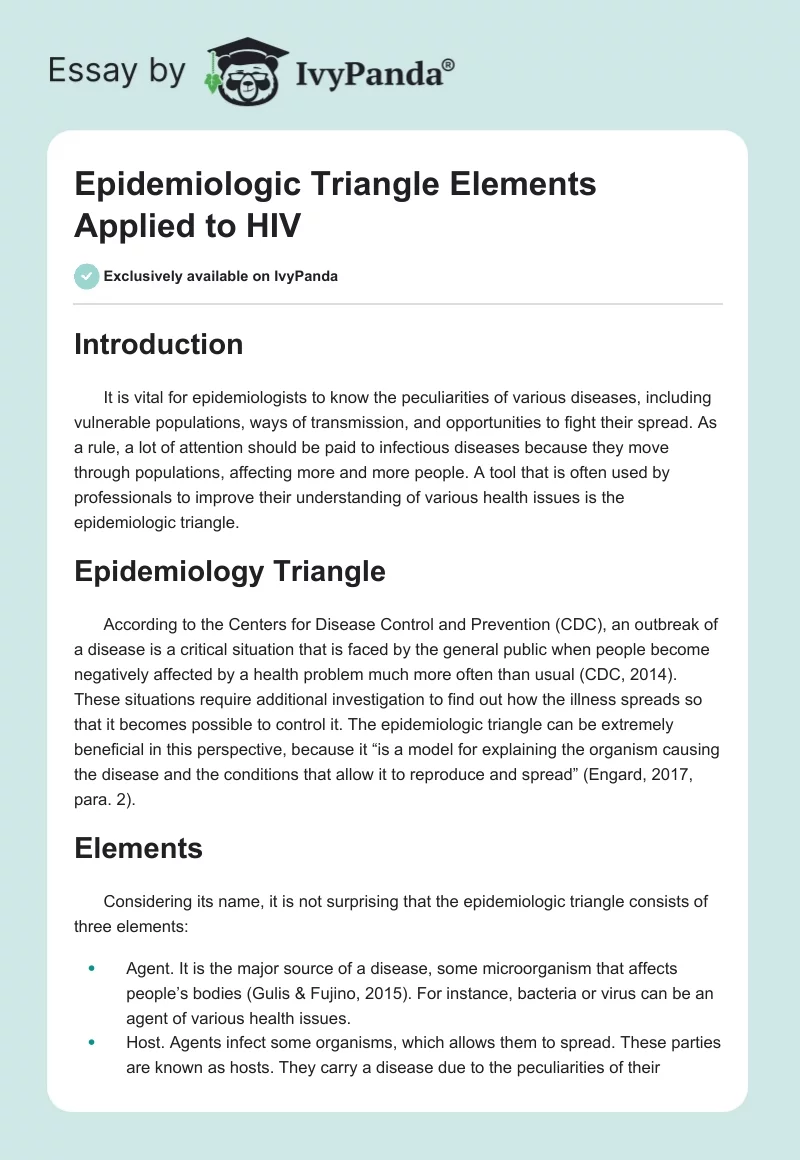Introduction
It is vital for epidemiologists to know the peculiarities of various diseases, including vulnerable populations, ways of transmission, and opportunities to fight their spread. As a rule, a lot of attention should be paid to infectious diseases because they move through populations, affecting more and more people. A tool that is often used by professionals to improve their understanding of various health issues is the epidemiologic triangle.
Epidemiology Triangle
According to the Centers for Disease Control and Prevention (CDC), an outbreak of a disease is a critical situation that is faced by the general public when people become negatively affected by a health problem much more often than usual (CDC, 2014). These situations require additional investigation to find out how the illness spreads so that it becomes possible to control it. The epidemiologic triangle can be extremely beneficial in this perspective, because it “is a model for explaining the organism causing the disease and the conditions that allow it to reproduce and spread” (Engard, 2017, para. 2).
Elements
Considering its name, it is not surprising that the epidemiologic triangle consists of three elements:
- Agent. It is the major source of a disease, some microorganism that affects people’s bodies (Gulis & Fujino, 2015). For instance, bacteria or virus can be an agent of various health issues.
- Host. Agents infect some organisms, which allows them to spread. These parties are known as hosts. They carry a disease due to the peculiarities of their physiology. They may be more vulnerable or attractive than other organisms that is why they are selected by agents. It is also vital to consider the fact that hosts can reveal no symptoms of a disease.
- Environment. An outbreak of diseases is greatly influenced by various factors. All of them are generally treated as the environment. It may include any outside force except for the agent and the host. Anyway, the spread of a disease is to be affected (Virtual Campus for Public Health, n.d.). For instance, the temperature or the quality of water can be these factors.
Application
Currently, professionals pay attention to various health issues. Still, HIV seems to be discussed more often than others. Even though its prevalence decreases constantly due to the developed interventions, more than a million Americans deal with this problem today (CDC, 2017). The Epidemiologic Triangle can be used to understand the communication of HIV better and improve interventions aimed at its prevention:
- Agent. HIV affects the human immune system. It is caused by a viral infection. As this health issue influences the immune system adversely, it prevents people’s bodies from protecting themselves from other agents. In addition to that, individuals become unable to fight HIV under this condition. This infection is transmitted in different ways, but direct contact between the host and another individual is required. As a rule, this happens during intercourse. Among the most common ways of communication is also the use of shared needles.
- Host. Currently, professionals assume that HIV was transmitted to people from chimpanzees through their infected meat and blood. It is communicated when bodily fluids are shared.
- Environment. The spread of HIV is greatly affected by socioeconomic factors. These may include poverty, a high concentration of sexually transmitted diseases, and poor access to healthcare services.
Conclusion
Thus, it can be concluded that the Epidemiologic Triangle provides professionals with an opportunity to improve their understanding of real-world disease transmission. It does not only encourage them to focus on a critical connection between the agent and the host but also allows considering the way it is influenced by different factors.
References
CDC. (2014). Glossary. Web.
CDC. (2017). Statistics overview. Web.
Engard, B. (2017). What is the epidemiologic triangle? Web.
Gulis, G., & Fujino, Y. (2015). Epidemiology, population health, and health impact assessment. Elsevier, 25(3), 179-180.
Virtual Campus for Public Health. (n.d.). Epidemiologic triad. Web.


